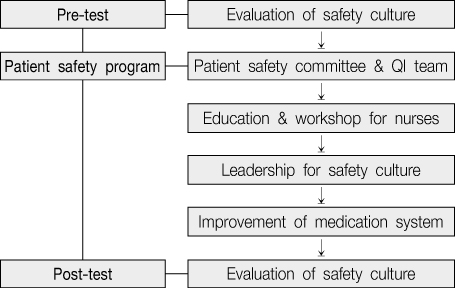J Korean Acad Nurs Adm.
2010 Dec;16(4):455-465.
Patient Safety Program and Safety Culture
- Affiliations
-
- 1Department of Nursing, Seoul National Hospital, Korea.
- 2College of Nursing, Eulji University, Korea. sarakimk@eulji.ac.kr
- 3Jeju regional Cancer Center, Korea.
Abstract
- PURPOSE
To determine the impact of the Patient Safety Program on the safety culture of nursing department.
METHODS
Patient Safety Program focused on medication safety was launched by QI team and patient safety committee. Patient Safety Program was composed of the establishment of improved reporting system as s way to learn from error, 'Patient Safety Guard' movement, and continuous education for medication safety. With one group pretest-posttest design, nurses' perception of the safety culture were measured with self-administered questionnaire. Subjects were all nurses and managers in nursing department of a tertiary teaching hospital in Seoul. Collected data from survey was statistically analyzed using t-test.
RESULTS
Patient Safety Program had been continued for 20 months in participation of all nurses and managers. Safety culture was improved (pretest=2.84, posttest=2.90, p<.001; 4 point scale).
CONCLUSIONS
This study indicates that there has been a statistically significant increase in the nurses' perception of safety culture. These findings suggest that Patient Safety Program had made great contribution toward system wide safety culture in the hospital. To improve safety culture, leadership supports and flexibility to apply tailored interventions to the hospital were required necessarily.
Keyword
Figure
Reference
-
1. Abbott PA. Research in patient safety/error reduction: A nursing perspective. Session presented at post-conference for 8th International Congress in Nursing Informatics. 2003. Rio De Janeiro, Brazil.2. Ahn SH. Analysis of risk factors for patient safety management. J Korean Acad Nurs Adm. 2006. 12(3):373–384.3. AHRQ. Patient safety network. glossary. 2004. Retrieved November 30. from http://www.psnet.ahrq.gov/glossary.aspx.4. Choi JH, Lee KM, Lee MA. Relationship between hospital nurses' perceived patient safety culture and their safety care activities. J Korean Acad Fundam Nurs. 2010. 17(1):64–72.5. Curtin LL. When negligence becomes homicide. Nurs Manage. 1997. 28(7):7–8.6. Duncombe D. DFCI patient safety journey. Paper presented at the Lecture for Korean Hospital Nurses Association Study Group. 2006. 09. Boston, MA: Institute for Nursing Healthcare Leadership.7. Edgar TA, Lee KS, Cousins DD. Experience with a national medication error reporting program. Am J Hosp Pharm. 1994. 51(10):1335–1338.
Article8. Joint Commission Resources. Root cause analysis in health care: Tools and techniques. 2005. 3rd ed. Oakbrook Terrace, IL: Author.9. Jeong J, Seo YJ, Nam EW. Factors affecting patient safety management activities at nursing divisions of two university hospitals. Korean J Hosp Manage. 2006. 11(1):91–109.10. Kizer KW. Large system changer and a culture of safety. Enhancing Patient Safety and Reducing Errors in Health Care. 1999. Chicago: National Patient Safety Foundation.11. Kim EK, Kang M, Kim HJ. Experience and perception on patient safety culture of employees in hospitals. J Korean Acad Nurs Adm. 2007. 13(3):321–334.12. Kim JE, Kang MA, An KE, Sung YH. A survey of nurses' perception of patient safety related to hospital culture and reports of medical errors. Clin Nurs Res. 2007. 13(3):169–179.13. Kim YL. Perceptions of patient safety culture of hospital nurses. 2009. Jeonju: Chonbuk National University;Unpublished master's thesis.14. Kohn LT, Corrigan JM, Donaldson MS, editors. To Err Is Human: Building a Safer Health System. 1999. Washington, DC: National Academy Press.15. Leape LL, Brennan TA, Laird N, Lawthers AG, Localio AR, Barnes BA, Hebert L, Newhouse JP, Weiler PC, Hiatt H. The nature of adverse events in hospitalized patient. N Engl J Med. 1991. 324(6):377–384.
Article16. Noh YN. Analysis of perception patient safety culture among hospital workforce. 2008. Seoul: Yonsei University;Unpublished master's thesis.17. Page AEK. Keeping patients safe: Transforming the work environment of nurses. 2004. Washington, D.C.: Institute of Medicine, The National Academies Press.18. Park SJ. A study on hospital nurses' perception of patient safety culture and safety care activity. 2008. Busan: Dong-A University;Unpublished master's thesis.19. Patient safety and Quality Improvement Act. 2005. Retrieved June 10, 2009. from http://www.ahrq.gov/qual/psoact.htm.20. Pepper G. Errors in drug administration by nurses. Am J Health Syst Pharm. 1995. 52(4):390–395.
Article21. Pronovost PJ, Weast B, Holzmuller CG, Rosestein BJ, Kidwell RP, Haller KB, Feroli ER, Sexton JB, Rubin HR. Evaluation of the culture of safety: survey of clinicians and managers in an academic medical center. Qual Saf Health Care. 2003. 12(6):405–410.
Article22. Secatore J. Safety and quality: The big picture. Paper presented at the Lecture for Korean Hospital Nurses Association Study Group. 2006. 09. Boston, MA: Institute for Nursing Healthcare Leadership.23. Spath PL. Patient safety improvement guidebook. 2000. Retrieved November 11, 2001. Forest Grove, OR: Brown-Spath & Associates;from http://www.brownspath.com/catalog.htm.24. Weingart SN, Farbstein K, Davis RB, Phillips RS. Using a Multihospital Survey to Examine the Safety Culture. Jt Comm J Qual Saf. 2004. 30(3):125–132.
Article25. Weingart SN, Page D. Implications for practice: challenges for healthcare leaders in fostering patient safety. Qual Saf Health Care. 2004. 13:Suppl 2. ii52–ii56.
Article26. Woolever DR. Henriksen K, Battles JB, Marks ES, editors. The impact of a patient safety program on medical error reporting. Advances in Patient Safety: From Research to Implementation (Volume 1: Research Findings). 2005. Rockville (MD): Agency for Healthcare Research and Quality (US);307–316.
Article
- Full Text Links
- Actions
-
Cited
- CITED
-
- Close
- Share
- Similar articles
-
- Effects of Nurses' Patient Safety Management Importance, Patient Safety Culture and Nursing Service Quality on Patient Safety Management Activities in Tertiary Hospitals
- Nurses' Perceptions of Patient Safety Culture and Patient Safety Activities in Mental Health Hospitals
- Effects of Perceived Patient Safety Culture on Safety Nursing Activities in the General Hospital Nurse's
- Perception of Patient Safety Culture and Safety Care Activity of Entry-level Nurses
- Perception of Workers on Patient Safety Culture and Degree of Patient Safety in Nursing Homes in Korea


